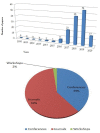A systematic review and Meta-data analysis on the applications of Deep Learning in Electrocardiogram
- PMID: 35821879
- PMCID: PMC9261902
- DOI: 10.1007/s12652-022-03868-z
A systematic review and Meta-data analysis on the applications of Deep Learning in Electrocardiogram
Abstract
The success of deep learning over the traditional machine learning techniques in handling artificial intelligence application tasks such as image processing, computer vision, object detection, speech recognition, medical imaging and so on, has made deep learning the buzz word that dominates Artificial Intelligence applications. From the last decade, the applications of deep learning in physiological signals such as electrocardiogram (ECG) have attracted a good number of research. However, previous surveys have not been able to provide a systematic comprehensive review including biometric ECG based systems of the applications of deep learning in ECG with respect to domain of applications. To address this gap, we conducted a systematic literature review on the applications of deep learning in ECG including biometric ECG based systems. The study analyzed systematically, 150 primary studies with evidence of the application of deep learning in ECG. The study shows that the applications of deep learning in ECG have been applied in different domains. We presented a new taxonomy of the domains of application of the deep learning in ECG. The paper also presented discussions on biometric ECG based systems and meta-data analysis of the studies based on the domain, area, task, deep learning models, dataset sources and preprocessing methods. Challenges and potential research opportunities were highlighted to enable novel research. We believe that this study will be useful to both new researchers and expert researchers who are seeking to add knowledge to the already existing body of knowledge in ECG signal processing using deep learning algorithm.
Supplementary information: The online version contains supplementary material available at 10.1007/s12652-022-03868-z.
Keywords: Biometric Electrocardiogram System; Deep learning; Driving; Electrocardiogram; Machine learning.
© The Author(s), under exclusive licence to Springer-Verlag GmbH Germany, part of Springer Nature 2022.
Conflict of interest statement
Conflict of interestNo competing interests are reported by the authors.
Figures






















References
-
- Abbas Q. HybridFatigue: A Real-time Driver Drowsiness Detection using Hybrid Features and Transfer Learning. (IJACSA) Int J Adv Comput Sci Appl. 2020;11(1):585–593.
-
- Abdeldayem SS, Bourlai T. A Novel Approach for ECG-Based Human Identification Using Spectral Correlation and Deep Learning. IEEE Trans Biometrics Behav Identity Sci. 2019;2(1):1–14.
-
- Acharya UR, Fujita H, Lih OS, Adam M, Tan JH, Chua CK. Automated detection of coronary artery disease using different durations of ECG segments with convolutional neural network. Knowl Based Syst. 2017;132:62–71. doi: 10.1016/j.knosys.2017.06.003. - DOI
-
- Acharya UR, Fujita H, Lih OS, Hagiwara Y, Tan JH, Adam M. Automated detection of arrhythmias using different intervals of tachycardia ECG segments with convolutional neural network. Inf Sci. 2017;405:81–90. doi: 10.1016/j.ins.2017.04.012. - DOI
-
- Acharya UR, Fujita H, Oh SL, Hagiwara Y, Tan JH, Adam M. Application of deep convolutional neural network for automated detection of myocardial infarction using ECG signals. Inf Sci. 2017;415:190–198. doi: 10.1016/j.ins.2017.06.027. - DOI
LinkOut - more resources
Full Text Sources
Miscellaneous
